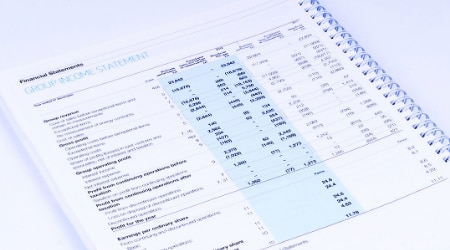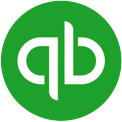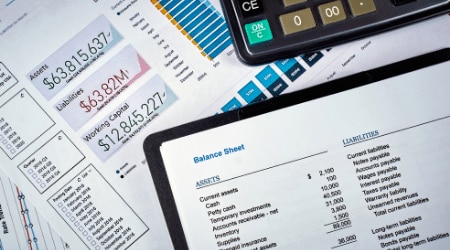In this article, you will learn:

General Ledger: Meaning, Classification, and Examples
What is General Ledger?
A general ledger is a record or collection of accounts containing individual accounts that showcase any transactions related to each of the accounts and that detail the necessary information of these accounts.
A general ledger helps you to know the ultimate result of all the transactions that take place with regards to specific accounts on a given date. For this reason, general ledger is also known as the Principal Book of Accounting System.
You need to record business transactions in your books of accounts based on the dual aspect of accounting. So, as per the Duality Principle, each transaction will involve a minimum of two accounts, meaning one account will increase while the other decreases. This system of debit and credit helps in finding out the final position of every item at the end of the given accounting period.
Now, each of your transactions will follow a procedure before they are entered in the final books of accounts. First, the transactions are recorded in the original book of entry, known as the journal. Once the journal is complete, these transactions are then posted to individual accounts contained in general ledger.
So, if you want to know the amount a customer is expected to pay on a particular date, you'll need to refer to your Customer’s Account in your general ledger. Similarly, you need to refer to the Creditor’s Account in your general ledger if you want to know the amount you are liable to pay to him on a specific date.
The Simplified Meaning of a General Ledger
A general ledger is a principal book that records all the accounts of your company and is one of the important books of accounts for your business, as all the accounting entries are transferred from the journal to the ledger.
This means you first need to record a business transaction in your journal, and remember to record them in the order in which they occur. Once you record the transaction in the journal, you're then required to classify and transfer it into a specific general ledger account.
Therefore, a general ledger contains individual accounts in which similar transactions are recorded, whether relating to an asset, a liability, an individual, or an expense.
Here is an example of how you can transfer the journal entries to a general ledger.
Example
Say you own a publishing house, Martin & Co., and purchased 20kg of paper on cash at $20 per kg on December 1, 2020. Therefore, the following is the journal and ledger that you need to record into books for such a transaction.
| Date | Particulars | L.F. | Debit Amt (USD) | Credit Amt (USD) |
| 1/1/2020 | Purchases | 400 | ||
| To Cash | 400 | |||
| (20kg Paper Purchased from William Paper Mill at $20 per kg) |
This journal entry would then be transferred to the respective ledger accounts as follows.
| Cash Account | |||||||
| Dr. | Cr. | ||||||
| Date | Particulars | J.F. | Amt (USD) | Date | Particulars | J.F. | Amt (USD) |
| 1/1/2020 | Purchases | 400 | |||||
In other words, you record the relevant transactions under the individual general ledger accounts, which are recorded based on the Duality Principle of Accounting.
As per this principle, there are at least two accounts involved when a particular transaction takes place. The Duality Principle is expressed as follows:
Assets = Liabilities + Capital
This equation states that the assets of your business are always equal to the sum of the owner’s capital and the claims of the outsiders.
As a result, each transaction of your business takes place in such a way that this equality between the two sides of the accounting equation is always maintained. That is, at any point in time, the resources or the assets of your business must equate to the claims of owners and outsiders. This is because owners and the outsiders are the ones who go in for providing such resources.
Classification of General Ledgers
Typically, there are three different types of ledgers that you can prepare, these include:
Debtors Ledger or Sales Ledgers
A sales ledger, or debtors ledger, is one of the three types of ledgers that you prepare as a firm or a business entity. It records all the transactions that take place between you and your debtors. In this instance, debtors refer to the business entities to whom you have sold goods that you manufacture.
It contains a collection of accounts associated with your customers and showcases the amount that is yet to be received from your customers. In addition to this, it also records the goods that your customers return.
As a result, your sales ledger tracks detailed information about the goods sold to your customers. The following details are recorded in your ledge:
- Date of Sale
- Type of goods sold
- Amount of goods
- Name of the customers
- Tax Details, etc.
You can refer back to the details regarding the sales made and helps you to keep track of payments that have been received or yet to be received from your customers.
Creditors Ledger or Purchases Ledger
A purchases ledger, or creditors ledger, records all transactions relating to purchases that a business entity makes. It also showcases the amount you pay to your suppliers or the amount yet to be paid for any purchases.
A purchases ledger helps you to keep a track of the purchases your business makes, so you can make sure that you have enough purchases for the smooth manufacturing of the products. It also details the amount you pay to the creditors as well as the outstanding amount. Besides this, you can refer back to the purchase details in case you need to so in the future.
Finally, the purchase ledger also helps you to know the following:
- Type and quantity of goods you purchased
- List of suppliers
- Purchases involving huge sums of money
General Ledger
A general ledger contains all the ledger accounts outside of the sales and purchases accounts. Therefore, you need to prepare various sub-ledgers providing the requisite details to prepare a general ledger.
A general ledger contains information related to different accounts, providing information that helps you in preparing your business’ financial statements, including income statements and balance sheets.
The information recorded in a general ledger is divided based on the type of accounts, including:
- Assets
- Liabilities
- Owner’s Equity
- Revenues and Gains
- Expenses or Losses
Benefits of General Ledger
A general ledger is one of the important records in the system of accounting as it record various transactions under separate account heads. These include sales accounts, purchases accounts, inventories accounts, etc.
As a result, such a record helps you in tracking various transactions related to specific account heads, and it also helps speed up the process of preparing books of accounts.
Preparation of Financial Statements
You cannot prepare financial statements, like Trading and P&L, or balance sheets without General Ledger, and the detailed accounts in the ledger help you in preparing the trial balance.
The trial balance ensures that the information contained in your ledger is accurate, so you can further use the accurate amounts showcased in your trial balance to prepare the financial statements, including income statements and balance sheets.
So, preparing these financial statements becomes challenging if you do not prepare general ledger, meaning you, as a business owner, won't be able to evaluate your company’s liquidity, profitability, and overall financial position.
Final Position of Specific Accounts
You record the financial transactions under separate account heads in your company’s general ledger, so at the end of the accounting period, you close these accounts. You do this as a result of balancing the debit and the credit sides of such accounts.
As a result, you'll get an understanding of your company’s position with regards to debtors, creditors, expenses, revenue, income, etc. For example, any outstanding payments against suppliers or any payments to be collected from customers.
Easy Audit
You may choose to conduct an internal audit or get your accounts audited by an accounting professional, so your general ledger acts as an important financial record. This is because your general ledger accounts record transactions under various account heads, providing detailed information on such accounts.
Having a general ledger may help the audit run smoothly, because you can easily verify information if various accounting items are classified and recorded accurately. As a result, general ledger accounting also helps you to spot material misstatements with regard to various accounts.
The accounting professional auditing your company accounts may also ask for things like sales receipts, purchase invoices, in order to check if proper amounts were charged. So, all of this becomes easy when you prepare proper ledger accounts.
Easy Tax Filing
Having general ledger accounts help you record details of transactions that your business undertakes over an accounting period. For example, your sales ledger contains information like tax information, invoice number, goods sold, date of sale, and customer details.
Likewise, revenue and expense accounts give an accurate view of the incomes earned and/or the expenses incurred. These details come in handy as it means you won't have to look for invoices or bank statements at the time of filing tax returns, because the details recorded in your ledger accounts provide the details needed to file your tax returns.
Identification of Unusual Transactions
A number of transactions will happen during an accounting period, so it can become difficult for you to find unwanted transactions if you do not categorize the transactions in your general ledger
This could become a cause of concern for your business. Say, for instance, you were overcharged for an item you purchased, it then becomes challenging for you to identify this transaction if the ledger accounts are not prepared.
Assessment of Company’s Financial Health
General ledger accounts are the basis on which you prepare a trial balance, from which you are able to prepare statements of final accounts, including income statements and balance sheets. Such financial statements provide information on the profitability and overall financial position of your business.
In other words, you'll get a clear view of your business’s capacity to generate profits and the resources you have available in order to meet outsider’s claims.
Control Accounts
A control account operates the same as general ledger account but you record only the summarized information regarding a specific account. It does not contain detailed information related to such an account, so you need to refer to a related subsidiary ledger in order to get details of such a control account.
In this instance, a subsidiary ledger records detailed information of the related control account. Accounts receivable is most commonly used as a general Ledger control account.
As a result you simply record a summary of various balances in accounts receivable when you use it as a control account. These include a summary of:
- Credit sales
- Sales returns
- Cash collected from customers
- Discounts given during an accounting period
As a result, you do not record details of each sales transaction undertaken with your customers in the accounts receivable control account. But, you can refer to the related subsidiary account if you need to check any detail regarding the sales made to a specific customer.
For example, the following are the credit sales undertaken during an accounting period:
| Particulars | Amount (USD) |
| Credit Sales | 200,000 |
| 100,000 |
| 40,000 |
| 60,000 |
The credit sales figure of $200,000 would go into the accounts receivable control account. Whereas, the sales details of various debtors like Jack & Co., Mayers, and John can be found in the related subsidiary ledger.
Types of General Ledger Accounts
General ledger accounts can be put into five categories:
Asset Accounts
Assets are the resources your business owns, and these resources have the capacity to generate cash flows. Assets are items of economic value that can be converted into cash or cash equivalents.
The assets are categorized into current assets and fixed assets, and are typically reported on the left hand side of your company’s balance sheet.
An asset account typically includes the following:
- Cash
- Debtors
- Accounts receivable
- Inventory
- Land and building
- Plant and machinery
Liabilities Account
Liabilities are the amounts owed to individuals or outsiders, and are the financial obligations you're bound to fulfill. These are the obligations that you have to fulfill the amounts you have borrowed and which have not yet been paid for.
Liabilities can be represented on the right hand side of the balance sheet. Liabilities can also be further divided into current liabilities and non-current liabilities, these include:
- Creditors
- Outstanding expenses
- Accounts payable
- Long term loans
Stockholders Equity
The stockholder’s equity refers to the excess of assets over liabilities of your business. In other words, these are the assets remaining after you pay off all the debts and the liabilities.
Stockholder’s equity is the capital that your shareholders invest in your business in return for the company’s stock and retained earnings. It also includes share capital, retained earnings, and treasury stock. The shareholder’s equity appears on the liability side of your company’s balance sheet after current and non-current liabilities.
Operating Income Accounts
Operating Income is generated from your core business operations and helps you to know your capacity to generate profits from primary business activities.
Operating income includes sales revenue, income received as fees and commission, etc., and these incomes will depend on the type of business you undertake.
Operating Expense Accounts
Operating expenses are mandatorily incurred expenses that are necessary in the day-to-day operations of your business. These are the expenses that you would not be able to carry out your core business operations without, these include rent, payroll, insurance, etc.
Non-Operating or Other Income Accounts
Unlike pperating expenses, the non-operating incomes and expenses are one-time incomes or expenses that you either earn or incur. Neither are an outcome of your core business activity, nor are such expenses related to your core business operations.
Non-operating incomes and expenses include:
- Gain on Sale of Assets
- Loss on Sale of Assets
- Interest Expense
- Dividend Income
- Interest Income
Examples of General Ledger Accounts
All general ledger accounts can be classified into five categories:
Balance Sheet Accounts
Asset Accounts
- Cash
- Bank
- Inventory
- Accounts receivable
- Investments
- Machinery
- Land
- Equipment
- Furniture
Liability Accounts
- Accounts payable
- Notes payable
- Creditors
- Borrowings
- Accrued expenses payable
- Customer deposits
Stockholders Equity Accounts
- Common stock
- Retained earnings
- Treasury stock
Income Statement Accounts
Operating Income Accounts
- Sales
- Fees
Operating Expense Accounts
- Rent
- Salaries
- Advertising cost
- Depreciation
- Legal fees
- Insurance
- Office supplies
Non-Operating or Other Income Accounts
- Gain on sale of assets
- Loss on sale of assets
- Interest expense
- Interest income
- Dividend income
Reasons Why You Need a General Ledger?
A general ledger is the second most important book of entry after the Journal, because you record transactions under specific account heads in Ledger.
Unlike journal where transactions are recorded in chronological order as they occur, you record transactions in the ledger by classifying them under various account heads to which they relate.
In addition to this, your ledger contains detailed information with regards to every transaction. For instance, your Purchase Ledger contains the following supplier details:
- Supplier details
- Type of goods purchased
- Amount of goods bought, etc.
A ledger makes it easy for you to refer back to transactions in case you need to do so in the future. Besides this, you can also understand the following:
- How much do you owe to your suppliers
- Payments yet to be received
- Revenue earned
- Expenses incurred in a given accounting period
Having proper ledger accounts help you to prepare a trial balance sheet, meaning you can verify the accuracy of your accounts and prepare final accounts. These accounts may also include the income statement and balance sheet.
A general ledger helps you to know the overall profitability and financial health of your business. In addition to this, the information contained in general ledgers help you to run any audits smoothly.
In a general ledger, you can easily find information like a sales transaction, purchase transaction, etc. Needless to say, General Ledger is one of the primary books of entry and it forms the basis of your financial statements and helps you in evaluating the financial affairs of your firm.
What is a GL Reconciliation Process?
Reconciliation of your general ledger helps you to ensure accuracy of the information contained in your general ledger accounts.
This is done by comparing balances that appear on the ledger accounts to those on the original documents, such as bank statements, invoices, credit card statements, purchase receipts, etc.
If you identify errors or misstatements, you can then take the requisite actions to make good the errors. If you are preparing the journal or ledger manually, you or your accountant will need to go through each of the accounts individually.
You also match general ledger account balances to source documents to see if the accounts are accurate. However, with online accounting software like QuickBooks, general ledger reconciliation has become a lot easier.
This is because you, or an accounting professional, are no longer required to go through the pain of recording the transactions in the journal first before transferring them to the ledger.
These are the steps that you'll need to follow when undertaking a general ledger reconciliation:
Check Opening and Ending Balances
You need to compare the closing trial balances of previous accounting periods to the opening balances of the current period's ledger accounts. In doing so, you'll need to check the balance sheet accounts for details like assets, liabilities, and stockholder’s equity.
Income statement accounts, like operating and non-operating income, and expenses start afresh with every accounting period. So, at the beginning of the accounting period, these accounts must have a NIL balance.
Such an investigation helps you to avoid errors later, and, with an online accounting software like QuickBooks, such a comparison becomes a lot easier.
Review Individual General Ledger Accounts
You need to check the transaction amounts recorded as part of your general ledger. If you are preparing your general ledger manually, you will have to keep your source documents handy. These sources will help to verify that the amounts recorded in the ledger accounts are accurate.
However, reconciling individual account balances becomes extremely easy with online accounting software like QuickBooks. This is because the software comes with a Bank Reconciliation feature. This feature automatically matches the transactions recorded in your books of accounts with the bank statement balances.
Find out how to connect your bank in the video below.
Recording Correct Entries
Suppose you discover after reconciliation that certain amounts were not correctly recorded in your ledger. It could be due to an entry with an incorrect amount or an entry you completely omitted to record in your general ledger accounts.
For example, if you identified that a payment of $1,000 to your vendor William Paper Mill was wrongly recorded as $100, the best practice is to reverse the original entry and then record a new entry with the correct amount.
| Original Entry | ||
| Particulars | Debit | Credit |
| William Paper Mill | $100 | |
| To Cash | $100 | |
| Reverse Entry | ||
| Particulars | Debit | Credit |
| Cash | $100 | |
| To William Paper Mill | $100 | |
| Correct Entry | ||
| Particulars | Debit | Credit |
| Cash | $100 | |
| To William Paper Mill | $100 | |
Recording Adjusting Entries
Adjusting entries are prepared at the end of an accounting period to consider income or expenses that have not yet been recorded in the general ledger. This is done to ensure that your financial statements are accurate. As a result, these entries can be for accrued expenses, accrued revenues, prepaid expenses, deferred revenues, and depreciation.
For example, you'll need to record rent expenses every month if you rent computers and decide to prepay the rent in January for the next twelve months. This is done because you do not want to understate any expenses in your financial statements for the next 12 months.
Say, you record a Prepaid Rent of $500 at the end of every month, the adjusting entry would be as follows.
| Adjusting Entry | ||
| Particulars | Debit | Credit |
| Rent | $500 | |
| To Prepaid Rent | $500 | |
Preparing Financial Reports
You can prepare financial statements once you have verified the accuracy of your ledger accounts.
What is the GL Code?
General ledger codes are the numeric codes assigned to different General Ledger Accounts. These accounts help in organizing the general ledger accounts properly and recording transactions quickly.
It can be very difficult to organize if you have a huge number of transactions in a given accounting period, which is where GL Codes can come handy. As you can more easily find transactions you are searching for in your general ledger if you have a code for every transaction.
You'll also need to decide how to assign such codes. For instance, you could assign four-digit codes for all your accounts, or you could assign specific numbers to specific accounts.
















